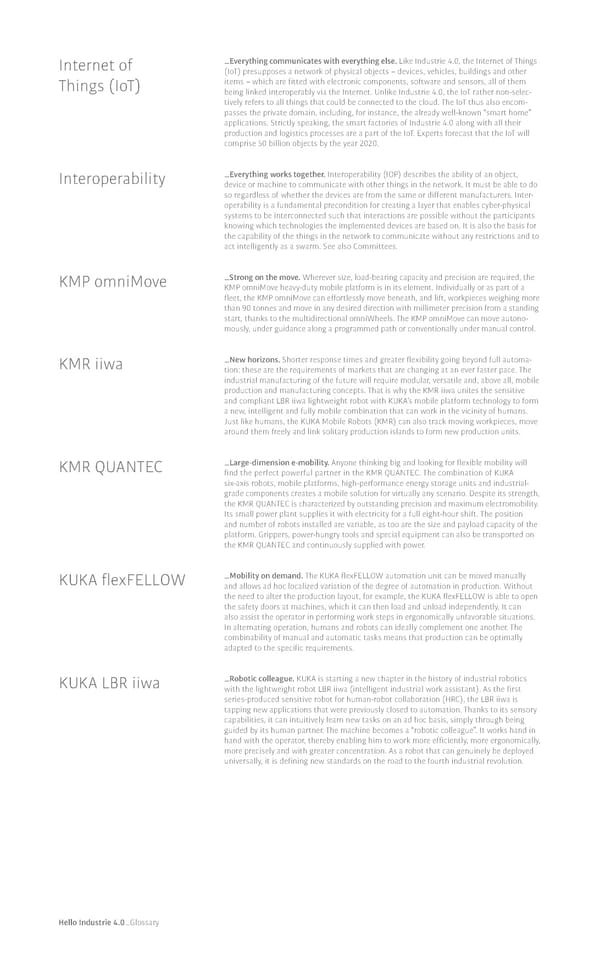Internet of �Everything communicates with everything else. Like Industrie 4.0, the Internet of Things (IoT) presupposes a network of physical objects – devices, vehicles, buildings and other Things (IoT) items – which are fitted with electronic components, software and sensors, all of them being linked interoperably via the Internet. Unlike Industrie 4.0, the IoT rather non-selec- tively refers to all things that could be connected to the cloud. The IoT thus also encom- passes the private domain, including, for instance, the already well-known “smart home” applications. Strictly speaking, the smart factories of Industrie 4.0 along with all their production and logistics processes are a part of the IoT. Experts forecast that the IoT will comprise 50 billion objects by the year 2020. Interoperability �Everything works together. Interoperability (IOP) describes the ability of an object, device or machine to communicate with other things in the network. It must be able to do so regardless of whether the devices are from the same or different manufacturers. Inter- operability is a fundamental precondition for creating a layer that enables cyber-physical systems to be interconnected such that interactions are possible without the participants knowing which technologies the implemented devices are based on. It is also the basis for the capability of the things in the network to communicate without any restrictions and to act intelligently as a swarm. See also Committees. KMP omniMove �Strong on the move. Wherever size, load-bearing capacity and precision are required, the KMP omniMove heavy-duty mobile platform is in its element. Individually or as part of a fleet, the KMP omniMove can effortlessly move beneath, and lift, workpieces weighing more than 90 tonnes and move in any desired direction with millimeter precision from a standing start, thanks to the multidirectional omniWheels. The KMP omniMove can move autono- mously, under guidance along a programmed path or conventionally under manual control. KMR iiwa �New horizons. Shorter response times and greater 昀氀exibility going beyond full automa- tion: these are the requirements of markets that are changing at an ever faster pace. The industrial manufacturing of the future will require modular, versatile and, above all, mobile production and manufacturing concepts. That is why the KMR iiwa unites the sensitive and compliant LBR iiwa lightweight robot with 阀阀’s mobile platform technology to form a new, intelligent and fully mobile combination that can work in the vicinity of humans. Just like humans, the 阀阀 Mobile Robots (KMR) can also track moving workpieces, move around them freely and link solitary production islands to form new production units. KMR QUANTEC �Large-dimension e-mobility. Anyone thinking big and looking for 昀氀exible mobility will 昀椀nd the perfect powerful partner in the KMR QUANTEC. The combination of 阀阀 six-axis robots, mobile platforms, high-performance energy storage units and industrial- grade components creates a mobile solution for virtually any scenario. Despite its strength, the KMR QUANTEC is characterized by outstanding precision and maximum electromobility. Its small power plant supplies it with electricity for a full eight-hour shift. The position and number of robots installed are variable, as too are the size and payload capacity of the platform. Grippers, power-hungry tools and special equipment can also be transported on the KMR QUANTEC and continuously supplied with power. 阀阀 昀氀exFELLOW �Mobility on demand. The KUKA flexFELLOW automation unit can be moved manually and allows ad hoc localized variation of the degree of automation in production. Without the need to alter the production layout, for example, the KUKA flexFELLOW is able to open the safety doors at machines, which it can then load and unload independently. It can also assist the operator in performing work steps in ergonomically unfavorable situations. In alternating operation, humans and robots can ideally complement one another. The combinability of manual and automatic tasks means that production can be optimally adapted to the specific requirements. 阀阀 LBR iiwa �Robotic colleague. KUKA is starting a new chapter in the history of industrial robotics with the lightweight robot LBR iiwa (intelligent industrial work assistant). As the first series-produced sensitive robot for human-robot collaboration (HRC), the LBR iiwa is tapping new applications that were previously closed to automation. Thanks to its sensory capabilities, it can intuitively learn new tasks on an ad hoc basis, simply through being guided by its human partner. The machine becomes a “robotic colleague”. It works hand in hand with the operator, thereby enabling him to work more efficiently, more ergonomically, more precisely and with greater concentration. As a robot that can genuinely be deployed universally, it is defining new standards on the road to the fourth industrial revolution. Hello Industrie 4.0�Glossary
 Embracing Industrie Page 95 Page 97
Embracing Industrie Page 95 Page 97